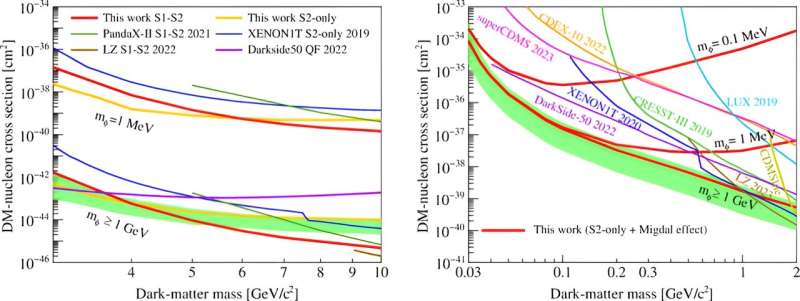November 25, 2023 feature
This article has been reviewed according to Science X's editorial process and policies. Editors have highlighted the following attributes while ensuring the content's credibility:
fact-checked
peer-reviewed publication
trusted source
proofread
From underground detectors to cosmic secrets: Exploring dark matter-nucleon interactions

In a new study, scientists report results from the PandaX-4T experiment, setting stringent limits on dark matter–nucleon interactions using low-energy data and the Migdal effect, ruling out significant parameter space for a thermal relic dark-matter model.
Dark matter is one of the great mysteries in science, eluding direct detection and defying traditional models. It is so shrouded in mystery that we don't even know what dark matter particles are and what their mass is.
This is because dark matter particles don't interact with light, making them impossible to detect. The leading candidates for dark matter particles are axions and weakly interacting massive particles (WIMPs).
In the depths of the China Jinping Underground Laboratory, the PandaX-4T experiment stands as a beacon in the quest to unravel the mysteries of dark matter. The experimental program employs 'xenon detectors' to explore dark matter, study neutrinos, and investigate new physics, such as neutrinoless double beta decay.
Now, scientists have reported progress in the search for dark-matter–nucleon interactions using the PandaX-4T. The findings are published in Physical Review Letters.
The PandaX-4T experiment and the Migdal effect
At the heart of the PandaX-4T experiment lies a state-of-the-art dual-phase xenon time projection chamber (TPC) housing a substantial 3.7 tons of liquid xenon within a sensitive volume. This sophisticated chamber serves as the primary arena for particle interactions.
Co-author Dr. Ran Huo from the Shandong Institute of Advanced Technology explained, "For light dark matter, the maximum energy the dark matter can transfer to the xenon nuclei is proportional to the dark matter mass squared."
"When the dark matter mass is below several GeV, the recoil energy due to dark matter collision with the xenon nuclei has almost no chance of exceeding the energy threshold of the detector."
The PandaX-4T experiment leverages the Migdal effect to overcome this challenge by enhancing the experiment's sensitivity, particularly to low-mass dark matter particles below 3 GeV, in an attempt to probe dark matter-nucleon interactions.

The Migdal effect involves the potential ionization or excitation of electrons in the atoms, making up the material (in this case, xenon) through which dark matter passes. The nucleons (protons and neutrons) within the atomic nuclei experience interactions with dark matter particles.
These interactions can lead to the excitation or ionization of electrons in the surrounding atoms. As a result, these electrons can acquire energies above keV. When these energized electrons pass through liquid xenon, they generate detectable signals indicative of electron recoils in the detector.
"Simply speaking, the Migdal effect helps us to extend our reach for dark matter masses below 3 GeV to probe the dark matter-nucleon interactions," said Dr. Yong Yang, co-author of the study from Shanghai Jiao Tong University.
A thermal dark matter model
In a thermal dark matter model, dark matter particles are assumed to have been in thermal equilibrium with the primordial soup of particles in the early universe. As the universe expanded and cooled, these particles decoupled from the thermal bath while preserving a certain abundance.
This process is akin to a freeze-out, where the dark matter particles freeze into their observed abundance.
The thermal dark matter model is particularly appealing because it provides a natural mechanism for explaining the observed relic abundance of dark matter in the universe. The 'annihilation' or decay of these particles in the early universe would have produced the correct density of dark matter we observe today.
This model often involves the consideration of specific types of particles, such as weakly interacting massive particles (WIMPs) or other candidates with similar properties.
"Our experiment was primarily designed for WIMP-like dark matter, in which case the 'force-mediator' (particle responsible for transmitting the force between dark matter and ordinary matter) is assumed to be very heavy, so the interaction is extremely short-ranged," noted Dr. Yang.
PandaX-4T model's flexibility aids in reproducing the observed amount of dark matter through the annihilation of dark matter particles into standard model particles during the early universe, showcasing a diverse parameter space.
PandaX-4T's targeted approach utilized optimized low-energy data to set strict constraints on dark matter-nucleon interaction strength for dark masses ranging from 0.03 to 2 GeV.
"The new analysis directly tests a kind of thermal dark matter model—dark matter pairs annihilating into ordinary matter via the dark photon in the early universe—and eliminates substantial parameter space that was previously considered plausible," explained Dr. Huo.
Essentially, the study refines our understanding by restricting the potential scenarios for dark matter interactions via the dark photon, which is the mediator.
Building on discoveries
The experiment's success in scrutinizing dark matter particles within the 0.03 to 2 GeV range offers valuable insights, refining our comprehension of a thermal dark matter model.
The researchers highlight two possible avenues for future studies with the PandaX-4T.
"We aim to enhance exposure, through increased data or a larger xenon target, to delve into lower dark matter–nucleon interaction cross-sections."
"This expanded exposure holds the potential to elucidate the intricacies of the background in the low-energy domain, predominantly influenced by cathode electrodes and micro-discharging noise," said Dr. Huo.
"On the other side, our study has no sensitivity for this interaction for dark matter lighter than 30 MeV, below which the Migdal effect cannot help us anymore. This means we need new detection methods," acknowledged Dr. Yang.
More information: Di Huang et al, Search for Dark-Matter–Nucleon Interactions with a Dark Mediator in PandaX-4T, Physical Review Letters (2023). DOI: 10.1103/PhysRevLett.131.191002
Journal information: Physical Review Letters
© 2023 Science X Network




















